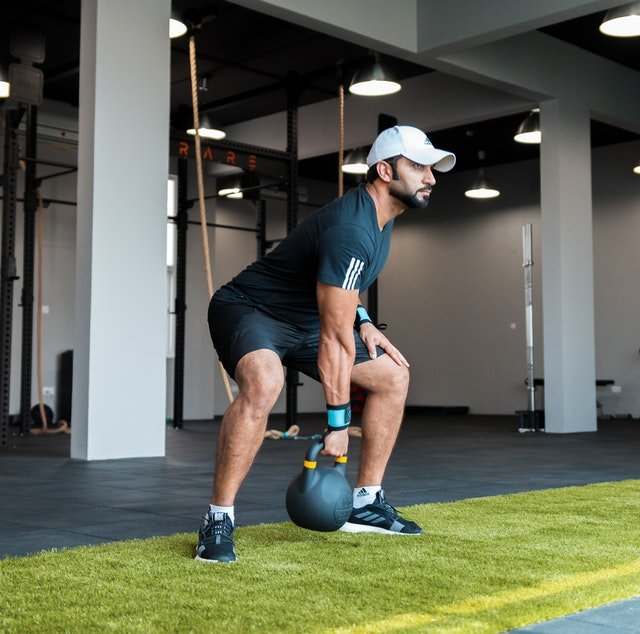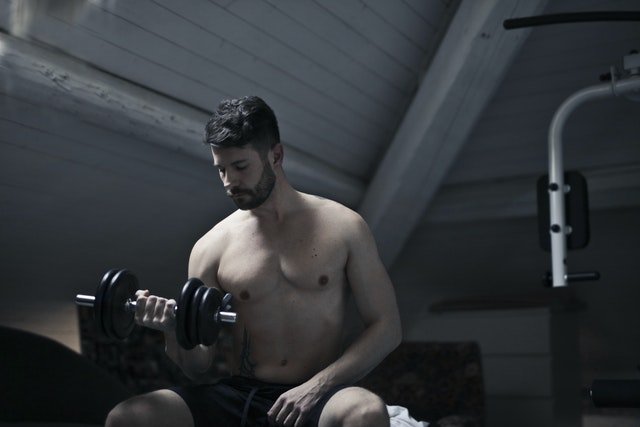Do Kettlebell Cleans Work Biceps? (All You Need To Know Here)
If you are new to using kettlebells, I’m sure you are enjoying the process and excited about all of the different ways you can use this simple, yet effective piece of equipment.
Kettlebell cleans are a great full-body workout, but you may be wondering if they work your biceps specifically.
Do Kettlebell Cleans Work Biceps?
Yes slightly, kettlebell cleans work the biceps. The biceps are worked when you pull the kettlebell up to your shoulder and while it is gripped by your hand when finishing the clean. The movement also works your forearms and trapezius muscles. There may be more activation in the biceps if you are using a heavy kettlebell, as they will be triggered more to lift and clean the kettlebell into position. The biceps will also be used more if you are new to doing the exercise and your form/technique needs a little work. The majority of the movement uses lower body muscles, but there is still an element of arm work. Kettlebell cleans are a great overall exercise for both the upper and lower body. If you are looking to work the biceps specifically, then you should be looking to exercises that isolate and work the muscle more.
Benefits of a kettlebell clean
The kettlebell clean is a great full-body exercise that not only works the biceps, but also the legs, glutes, back, and core.
It is a compound exercise that uses multiple joints and muscles at the same time. This makes it a great exercise for those who are short on time or are looking to get a quick, effective workout in.
The kettlebell clean is also a great exercise for those who are new to using kettlebells, as it is relatively simple to do and does not require any complex movements.
It is also a great exercise to add to your repertoire if you are looking to mix things up and keep your workouts interesting.
Are you new to kettlebell cleans?
If you are new to using kettlebells, I’m sure you are enjoying the process and excited about all of the different ways you can use this simple, yet effective piece of equipment.
Although kettlebell cleans are a fairly simple exercise, you must still ensure that you take the kettlebell and movement seriously. This will help to prevent injury and ensure that you are getting the most out of the exercise.
When performing kettlebell cleans, it is important to keep your core engaged and your back straight. You should also focus on using your legs to generate power, rather than your arms.
Kettlebell cleans are a great full-body workout, but can be dangerous if done wrong. Do some research or ask a certified professional for help before attempting this move.
Related: Can Kettlebells Cause Injury? (13 Vital Things To Consider)
What are your goals?
Before beginning any exercise routine, it is important to first assess your goals.
Do you want to build muscle? Do you want to lose weight? Do you want to improve your overall fitness level?
Once you have answered these questions, you can begin to tailor your workouts to better suit your needs.
If your goal is to build muscle, then you will want to focus on exercises that target the muscles you are looking to grow.
If your goal is to lose weight, then you will want to focus on exercises that help you burn calories and improve your cardiovascular health.
No matter what your goals are, kettlebell cleans can be a great addition to your workout routine.

How heavy is the kettlebell?
The weight of the kettlebell you use will be determined by your fitness level and goals. If you are new to using kettlebells, then I would recommend starting with a lighter weight.
This will help you get a feel for the movement and ensure that you are using proper form. As you become more comfortable with the exercise, you can begin to increase the weight.
Using a kettlebell that is too heavy will not only potentially cause an injury but will also compromise your form.
The movement of the exercise does involve the biceps a little, but they shouldn’t be used to pull the kettlebell into position.
If you are finding this is the case, then lower the weight to improve the movement. You may also find the exercise feels more natural using a lighter kettlebell.
One of the most common mistakes people make when using kettlebells is going too heavy too soon. Kettlebells can be misleading when it comes to picking the correct weight, so experiment and see what works for you.
Holding Kettlebell while racked utilises biceps
When you rack the kettlebell, your palms should be facing your body and your elbows should be close to your sides. This position will target the biceps more.
This is because you are using your biceps to keep the kettlebell in place and maintain the position.
Gripping the handle while the kettlebell is racked will work your biceps more too, although some kettlebell experts stress that you shouldn’t grip the kettlebell when racked, as it can cause wrist pain, strains, and other issues.
However, as long as you maintain a straight line from your elbow to the knuckle, you should be ok, as this will ensure there’s no wrist flexion or extension.
Compound movements
Kettlebell cleans are a compound movement, which means they work multiple joints and muscles at the same time.
The main muscles worked during kettlebell cleans are the quads, glutes, hamstrings, and lats. However, because it is a compound movement, your biceps will also get worked to some degree, along with various stabilizer muscles.
This is one of the benefits of compound movements; they help to build muscle and strength in multiple areas at the same time, which makes them very efficient.

Curling them out
If you are looking to isolate the biceps, there are a few exercises you can try, such as kettlebell curls, kettlebell preacher curls, and other isolation bicep exercises to work them directly.
Doing these in addition to compound movements that work your biceps indirectly, such as kettlebell cleans, can help you build bigger, stronger biceps.
If you are just focusing on several compound movements, you will get bigger arms anyway by default.
Here’s a list of the 6 fundamental compound kettlebell exercises:
- The Squat
- The Swing
- The Press
- The Clean
- The Snatch
- The Turkish Get Up
Related: Is A Kettlebell Swing A Push Or Pull? (All The Answers Here)
How is your technique?
Your technique is important when doing any exercise, but it is especially important when using kettlebells.
This is because kettlebells can be dangerous if used incorrectly. Make sure you are using the proper form and technique before attempting any new exercises.
As mentioned, when doing a kettlebell clean, the majority of explosion and propulsion comes from the lower body. The arms are only used to guide the kettlebell into position.
If you are using your arms too much, then you are not doing the exercise correctly. This can lead to injury and will also mean that you are not getting the full benefit of the exercise.
Ensure that you are driving through your heels, engaging your glutes and quads, and using your arms to guide the kettlebell.
Cleans, swings, and snatches jack up your posterior chain. Anterior musculature is a secondary mover in these exercises which can lead to some biceps development, but that’s not their primary purpose.
Final Thoughts…
Kettlebell cleans are a great compound movement that works multiple muscles and joints at the same time.
While they don’t directly target the biceps, they do work them to some degree, along with other stabilizer muscles.
If you want to focus on your biceps specifically, you can try doing kettlebell curls or other isolation exercises.
Remember to focus on proper form and technique to avoid injury and get the most out of the exercise.


